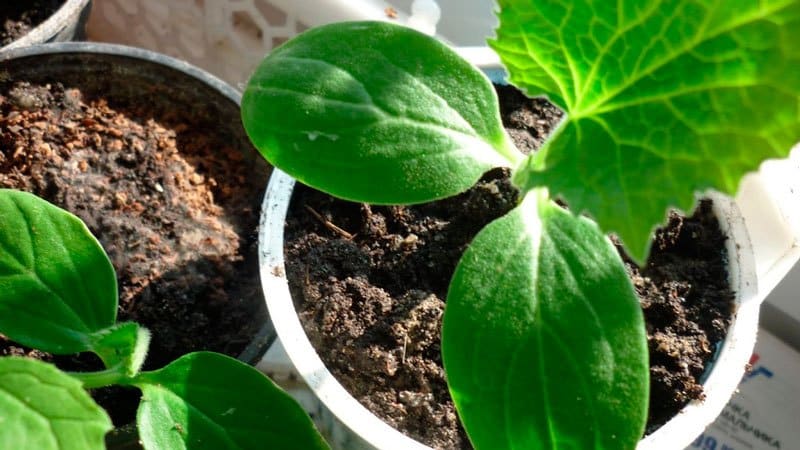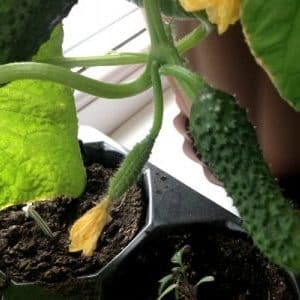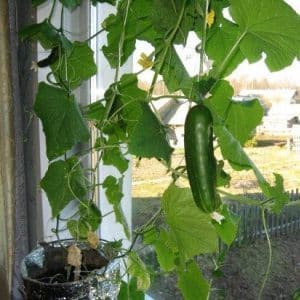How to grow cucumbers on a windowsill in an apartment: technology for growing a rich harvest
To grow a rich harvest of cucumbers, you don’t have to have your own garden plot. It is enough to find a variety that can be grown at home on a windowsill or balcony, and select suitable containers and soil. Most varieties are easy to care for and require a minimum of time and effort.
Let's look at the technology of growing cucumbers at home and learn how to plant, water and feed them correctly to get a big harvest.
Conditions for growing cucumbers on a windowsill
How to grow cucumbers on a windowsill? The culture is very sensitive to light and heat, so plantings are placed only on the southern sunny side. The plant should receive at least 15 hours of daylight per day. The optimal temperature for growing is +23 °C. If the house has a heated loggia, plants can be safely placed there too. Foil and reflectors will help get more light.
Important! When there is a lack of heat, phytolamps are used. They are LED, fluorescent and gas-charged. LED ones are especially popular. They are economical, give off light well and are durable. Their only drawback is their high cost.
Which seeds to choose
Purchase seed from trusted places. When purchasing, they study care recommendations, sowing dates, check the integrity of the packaging and expiration date. Large and even seeds are selected for planting. The traditional method will help check their suitability.Mix 30 g of table salt in 1 liter of water and immerse the planting material in the solution for 2 hours. During this time, large and heavy seeds sink to the bottom, and light ones remain on the surface. The solution is carefully drained, the suitable seeds are washed with clean water and dried.
Particular attention is paid to the choice of variety. Early ripening, self-pollinating cucumbers are preferred. Both hybrids and simple varieties are used. Some of them:
- Chinese kite;
- Moscow salad f1;
- Marinda f1;
- Lilliputian f1;
- Arbat;
- Athlete;
- Flagship.
What is the best way to grow cucumbers on a windowsill?

It is convenient to grow cucumbers in plastic or wooden boxes with drainage holes. They are affordable, lightweight and easy to use. All cucumbers are in one place; they can be quickly transferred from the windowsill to the balcony. The optimal height of boxes for seedlings is 10 cm. In addition to boxes, gardeners use the following options:
- Seedling pots made of plastic with special drainage holes. There are pots that are square, oval, and round. Square ones are compact, but cucumbers do not have enough space for development. Round ones are more convenient, but take up a lot of space on the windowsill. They are used repeatedly, year after year. The optimal width of the cucumber container is 7–10 cm.
- Trays for planting. This is the same box, the only difference is that there are partitions between the bushes. The trays are compact, take up little space, so they fit on any windowsill.
Preparing seeds and soil
Before planting, the seeds are disinfected and germinated.
For disinfection, seed material is soaked for 24 hours in Bordeaux mixture or potassium permanganate. Disinfection destroys pathogenic microflora, protects against diseases and pests.Seeds are also disinfected by regular heating, keeping them in the oven for 2 hours at a temperature of +180 °C.
The next stage of preparation is germination. It increases seed germination and strengthens the immunity of future plants. The most inexpensive and easiest way to sprout is soaking in water. Warm water is poured into a deep container and disinfected seeds are poured onto the bottom. Leave for 12 hours, while the liquid is changed every 4 hours and the seed is carefully mixed. Then the seeds are taken out of the water, wrapped in a gauze bag and put in a warm place for 3 days.
To plant seeds, use a ready-made mixture from the store, for example, “Universal” or “Strong” soil. Such land is already disinfected and equipped with all the necessary nutrients.
How and when to plant
When to plant cucumbers on the windowsill is up to you. It takes 50–60 days from germination to harvest. Cucumbers can be planted both in spring and winter. For example, by planting seeds in March, the harvest can be obtained by May; if planted in August, by November. Some gardeners use the lunar calendar to determine dates.
The landing procedure looks like this:
- pour soil into the container and make grooves 3–5 cm deep;
- 2-3 seeds are placed in each hole;
- sprinkle soil on top and gently pat down;
- water generously with warm water.
How to care
Cucumbers on a windowsill need the same care as those planted in open ground: regular watering, fertilizing, forming bushes and loosening the soil. Let us consider in detail how to correctly carry out each procedure.
Features of watering and fertilizing
Water balcony cucumbers once every 5 days. It is convenient to use a bottle for this.Direct the water directly to the root, bypassing the stems, to prevent the occurrence of fungi and infections. The optimal water temperature for irrigation is +18 °C. On the windowsill, the soil quickly loses moisture, so it is recommended to spray the bushes daily with water from a spray bottle. About 0.5 liters of water are consumed per plant. During the flowering period, the amount of moisture is reduced.
Before each watering, loosen the soil with a fork. Loosening makes the soil lighter and airier and saturates the roots with oxygen.
Fertilizers are applied 10–15 days after the first shoots appear. How to feed indoor cucumbers? The vegetable responds well to feeding with wood ash, ammonium nitrate, superphosphate, and nettle infusion. Regularly applied fertilizers improve the taste of fruits and increase productivity. To accelerate the development of cucumbers, the growth stimulator “Kornevin” is used. Before using the drug, carefully study the instructions for use.
Important! If the leaves dry out and turn yellow, it means that the bushes have been overfed with minerals. The interval between feedings should be at least 2–3 weeks. An excess of nitrogen leads to an increase in green mass, an excess of potassium leads to deformation of the fruit. For convenience, gardeners mark the dates of fertilizing on a calendar.
Forming and gartering cucumbers
When five leaves appear, the bush is pinched and weak lateral shoots are removed. Two or three main shoots are left, each of which pinching above the tenth sheet. Formation is carried out from the moment the first fruits appear until the harvest itself.
Only those cucumbers that grow many fruits weighing more than 80 g on one bush, and plants with long shoots, are tied up.If you do not tie it up, the stem will break under the heavy weight of the vegetables or the cucumbers will not have enough light and space for healthy development. They are tied with cotton bandages to wooden pegs.
Pollination
In indoor conditions, insects do not have access to plants, so cucumbers are pollinated by hand. This method is also necessary where several varieties of crops grow. If this is not done, the purity of the variety will be lost.
For pollination, use a brush with natural bristles, carefully collecting pollen from the male inflorescence and lubricating the pistils on the female buds. Pollination is carried out on the second day after the flower blooms. The humidity in the room should be at least 70%, otherwise the pollen will dry out.
Important! Cucumbers must be pollinated within two weeks from the moment the first ovaries appear.
Prevention of diseases and pests
Irrigation with cold water, lack of light, and contaminated soil lead to diseases. To avoid diseases and pests, it is recommended:
- Select large seeds for sowing and thoroughly disinfect them.

- Wash the planting container with baking soda in warm water.
- Disinfect the soil with a solution of potassium permanganate.
- Observe the regime of light and heat.
- Water the bushes only with warm and clean water.
- Pinch and shape plants in a timely manner.
- Treat cucumbers with Bordeaux mixture, wood ash solution, and whey.
- Regularly inspect bushes for signs diseases: dry and yellow leaves, brown spots, white bloom.
If not properly cared for, indoor cucumbers develop powdery mildew. White spots appear on the leaves, which can be removed by spraying with Previkur. Another disease, copperhead, appears as deep brown spots on fruits and leaves.The copperhead cannot be treated; infected bushes and cucumbers are removed.
Whiteflies and aphids are dangerous pests. Miniature white insects reproduce quickly and settle on the inside of the cucumber leaf. Because of them, the bushes dry out and cucumbers lose their taste. A tobacco-based decoction helps get rid of pests.
Reviews from gardeners
Both beginning gardeners and experienced gardeners grow cucumbers on the windowsill. The vegetable requires less attention than when grown on the plot.
Marina, Sochi: “I grow indoor cucumbers on a warm loggia. I plant them in wooden boxes, which I place on a pallet. I use the early ripening variety Zozulya. To get a rich harvest, I form a bush and pinch the top. The taste is excellent, no worse than garden vegetables.”
Ekaterina, Moscow region: “I decided to plant cucumbers at home for the first time, on the windowsill. I chose the Athlete and Chinese Snake varieties. The result exceeded all my expectations! Crispy, juicy and tasty cucumbers were loved by the whole family. I will definitely plant more.”
Irina, Orel: “The harvest of indoor cucumbers did not go well. The bushes are capricious, so I had to constantly monitor the moisture level. And pollinating cucumbers by hand turned out to be not as easy as I thought. It’s better to plant vegetables in the garden.”
Read also:
Why do pickles become soft in a jar and how to prevent it.
What are red cucumbers (Tladiantha dubious), why are they good?
Conclusion
Is it possible to grow cucumbers at home in pots? Yes, indoor cucumbers are grown in an apartment both in winter and in summer. For this purpose, early ripening varieties are preferred. Plant the vegetable in a convenient container with drainage holes. Use ready-made soil mixture or soil from the garden.In terms of care, indoor cucumbers are no different from garden ones. They need timely feeding and fertilizers. Compliance with agricultural cultivation techniques allows you to obtain a harvest of healthy vegetables at any time of the year.